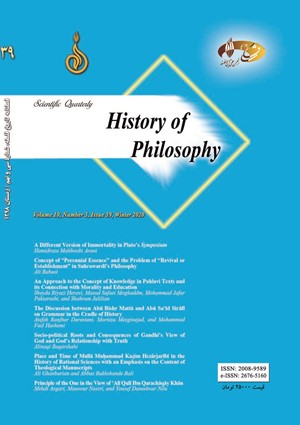Substance and Essence of Aristotle’s Ousia and its Translation into Substance and Reality
Subject Areas : Interation of thoughts, effects of philosophers’ ideas on society and future philosophical standpointsHamid Khosravani 1 , Hamidreza Mahboobi Arani 2
1 - MA in Islamic Philosophy and Kalam, Tarbiat Modares University, Tehran
2 - Assistant Professor, Philosophy, Wisdom and Logic Department, Tarbiat Modares University, Tehran, Iran
Keywords: Ousia gawhar jawhar reality existent being essence,
Abstract :
Aristotle’s ousia suffered the same fate it had in the West when it arrived in ancient Iran and the world of Islam. Among all the existing appropriate equivalents, the term “substance” was chosen as its nearest equivalent in western philosophical texts. Similarly, the term “jawhar”, which is the Arabic for “gawhar” in Persian and a close equivalent for substance, was accepted by all philosophers in the world of Islam. In previous translated works before and after the translation movement in Baghdad’s Dar al-Tarjumah (Translation House), there were some words such as ayn, inniyyat, huwiyyat, and budish which implied almost the true meaning of ousia as intended by Aristotle. This was because this term has been derived from the verb to be and basically means existent, essence, or being; however, jawhar and substance were the ultimate choices of translators. The dominance of this substantialist view, both in the West and in the East, was partly because of the early translations of Aristotle’s works. This paper aims to, firstly, examine the fate of Aristotles’s ousia upon its arrival in Iran and the world of Islam and, then, discuss the relationships between the meanings of the chosen equivalents in the Islamic world with those of their western equivalents.
ابن¬مقفع، عبدالله بن دادویه (1357) المنطق، مقدمه و تصحیح محمدتقی دانشپژوه، تهران: انجمن فلسفه ایران.
ارسطو (۱۳۶۶) متافیزیک (مابعدالطبیعه)، ترجمه شرف¬الدين خراسانی، تهران: حکمت.
ارسطو (۱۳۷۸) منطق ارسطو (اَرگانون)، ترجمة میرشمس¬الدین ادیب سلطانی، تهران: نگاه.
اکبریان، رضا (1386) «جوهر از دیدگاه ملاصدرا»، مجله دانشکده ادبیات و علوم انسانی دانشگاه اصفهان، ش 51، ص 68 ـ 41.
ایلخانی، محمد (۱۳۸۲) تاریخ فلسفه در قرون وسطی و رنسانس، تهران: سمت.
ایلخانی، محمد (1380) متافیزیک بوئتیوس، تهران: الهام.
ایلخانی، محمد (1385) «نظریه تشابه (analogia) در یونان»، مجله فلسفه، ش 2، ص92ـ 73.
ایلخانی، محمد (1386) «نظریه تشابه در آثار آلبرتوس کبیر و توماس آکوئینی»، مجله فلسفه، ش 1، ص 38ـ 5.
دهخدا، علیاکبر (1372) لغت¬نامه، تهران: دانشگاه تهران.
ریتر، یوآخیم و دیگران (۱۳۹۳) فرهنگ¬نامه تاریخی مفاهیم فلسفه، ج2، تهران: سمت.
فارابی، محمد بن محمد (۱۹۷۰.م) الحروف، تحقیق محسن مهدی، بیروت: دارالمشرق.
فرای، ریچارد ن. (۱۳۹۳) عصر زرین فرهنگ ایران، ترجمه مسعود رجبنیا، تهران: سروش.
فردوسی (1376) شاهنامه، بکوشش سعید محمدیان، تهران: قطره.
کراوس، پل (۱۹۴۶.م) التراجم الارسططالية المنسوبة الى ابن المقفع، ترجمة عبدالرحمان بدوی، قاهره: مکتبة ¬النهضة المصرية لوکری.
محسن افنان، سهیل (۱۴۰۴ق.) واژهنامه فلسفی، بیروت: دارالمشرق.
نصر، سیدحسین (1383) سنت عقلانی اسلامی در ایران، تهران: قصیده¬سرا.
نوس بام، مارتا کریون (۱۳۸۰) ارسطو، ترجمه عزتالله فولادوند، تهران: طرح نو.
Brown, S. F. (1996). Theology and Philosophy, Medieval Latin: An Introduction and Bibliographical Guide. Washington D.C.: CUA Press.
Descartes R. (2009). Principles of Philosophy. SMK Books.
https://plato.stanford.edu/archives/win2016/entries/aristotle-metaphysics.
https://www.macmillandictionary.com/dictionary/british/subscene.
Kosman, L. A. (2014). Virtues of thought: Essays on Plato and Aristotle. Cambridge, MA: Harvard university press.
Owens, J. (1951).The Doctrine of Being in the Aristotelian Metaphysics. Toronto: Pontifical Institute of Mediaeval Studies.
Spinoza, B. (2017).The Ethics. Loki's Publishing.


